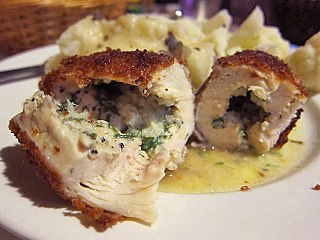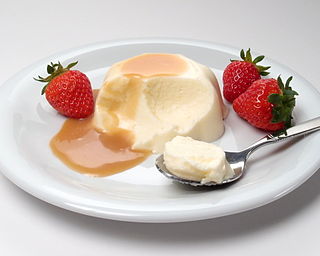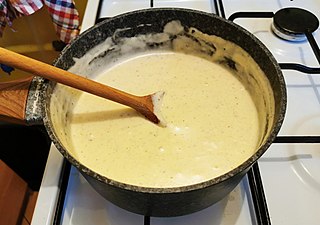
Espagnole sauce is a basic brown sauce, and is one of the mother sauces of classic French cooking. In the early 19th century the chef Antonin Carême included it in his list of the basic sauces of French cooking. In the early 20th century Auguste Escoffier named it as one of the five sauces at the core of France's cuisine.

Larousse Gastronomique is an encyclopedia of gastronomy first published by Éditions Larousse in Paris in 1938. The majority of the book is about French cuisine, and contains recipes for French dishes and cooking techniques. The first edition included few non-French dishes and ingredients; later editions include many more.

Suprême sauce is a classic and popular "daughter sauce" of French cuisine. It consists of velouté, a "mother sauce", thickened with cream and strained.

In cooking, a sauce is a liquid, cream, or semi-solid food, served on or used in preparing other foods. Most sauces are not normally consumed by themselves; they add flavor, texture, and visual appeal to a dish. Sauce is a French word probably from the post-classical Latin salsa, derived from the classical salsus 'salted'. Possibly the oldest recorded European sauce is garum, the fish sauce used by the Ancient Romans, while doubanjiang, the Chinese soy bean paste is mentioned in Rites of Zhou 20.

A cookbook or cookery book is a kitchen reference containing recipes.

Georges Auguste Escoffier was a French chef, restaurateur, and culinary writer who popularised and updated traditional French cooking methods. Much of Escoffier's technique was based on that of Marie-Antoine Carême, one of the codifiers of French haute cuisine; Escoffier's achievement was to simplify and modernise Carême's elaborate and ornate style. In particular, he codified the recipes for the five mother sauces. Referred to by the French press as roi des cuisiniers et cuisinier des rois, Escoffier was a preeminent figure in London and Paris during the 1890s and the early part of the 20th century.

Scrambled eggs is a dish made from eggs, where the whites and yolks have been stirred, whipped, or beaten together, then heated so that the proteins denature and coagulate, and they form into "curds".

Hollandaise sauce is a mixture of egg yolk, melted butter, and lemon juice. It is usually seasoned with salt, and either white pepper or cayenne pepper.

Blanquette de veau is a French veal stew. In the classic version of the dish the meat is simmered in a white stock and served in a sauce velouté enriched with cream and egg. It is among the most popular meat dishes in France.

Demi-glace is a rich brown sauce in French cuisine used by itself or as a base for other sauces. The term comes from the French word glace, which, when used in reference to a sauce, means "icing" or "glaze." It is traditionally made by combining one part espagnole sauce and one part brown stock. The sauce is then reduced by half, strained of any leftover impurities, and finished with a sherry wine.

Le répertoire de la cuisine is a professional reference cookbook written by Théophile Gringoire and Louis Saulnier and published in 1914; it has gone through multiple editions and been translated into multiple languages. It summarizes Le Guide culinaire by Auguste Escoffier, and adds a significant amount of Saulnier's own material.

Béarnaise sauce is a sauce made of clarified butter, egg yolk, white wine vinegar, and herbs. It is regarded as a "child" of hollandaise sauce. The difference is in the flavoring: béarnaise uses shallot, black pepper, and tarragon, while hollandaise uses white pepper or a pinch of cayenne.

Chicken Kiev, also known as chicken Kyiv and chicken à la Kyiv, is a dish made of chicken fillet pounded and rolled around cold butter, then coated with egg and bread crumbs, and either fried or baked. Since fillets are often referred to as suprêmes in professional cookery, the dish is also called "suprême de volaille à la Kiev". Stuffed chicken breast is generally known in Russian and Ukrainian cuisines as côtelette de volaille. Though it has disputed origins, the dish is particularly popular in the post-Soviet states, as well as in several other countries of the former Eastern Bloc, and in the English-speaking world.

Bavarian cream, crème bavaroise or simply bavarois is a French dessert consisting of an egg-based cooked custard and gelatin or isinglass, into which whipped cream is folded. The mixture sets up in a cold mold and is unmolded for serving. Earlier versions, sometimes called fromage bavarois, did not include eggs or any actual cheese. One recipe using isinglass also calls for crumbled amaretto cookies, chocolate and other flavorings. One contemporary French recipe for "bavarois" is a savory preparation with a neufchâtel-type cheese and leeks, and is not a sweet dessert.

The term supreme used in cooking and culinary arts refers to the best part of the food. For poultry, game and fish dishes, supreme denotes a fillet.

Duchess potatoes consist of a purée of mashed potato, egg yolk, and butter, which is forced from a piping bag or hand-moulded into various shapes which are then baked in a high temperature oven until golden. They are typically seasoned similarly to mashed potatoes with, for example, salt, pepper, and nutmeg. They are a classic item of French cuisine, and are found in historic French cookbooks.

À la Maréchale is a method of food preparation in haute cuisine. Dishes à la Maréchale are made from tender pieces of meat, such as cutlets, escalopes, supremes, sweetbreads, or fish, which are treated à l'anglaise ("English-style"), i.e. coated with eggs and bread crumbs, and sautéed.

A Pozharsky cutlet is a breaded ground chicken or veal patty that is typical of Russian cuisine. A distinct feature of this cutlet is adding butter to minced meat, which results in an especially juicy and tender consistency. The dish was created in the beginning of the 19th century in Russia and later adopted by French haute cuisine.

In French cuisine, the mother sauces, also known as grandes sauces in French, are a group of sauces upon which many other sauces – "daughter sauces" or petites sauces – are based. Different classifications of mother sauces have been proposed since at least the early 19th century.

Florentine or à la Florentine is a term from classic French cuisine that refers to dishes that typically include a base of cooked spinach, a protein component and Mornay sauce. Chicken Florentine is the most popular version. Because Mornay sauce is a derivation of béchamel sauce which includes roux and requires time and skill to prepare correctly, many contemporary recipes use simpler cream-based sauces.




















